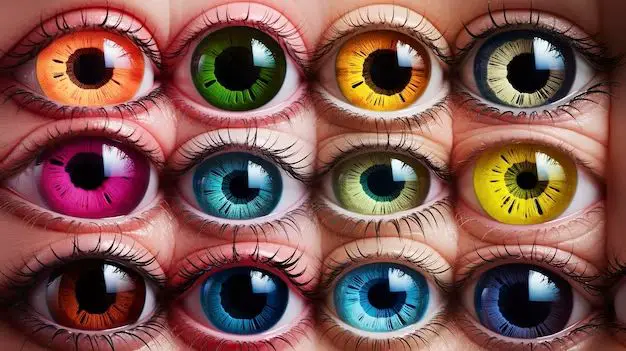Eye color is one of the most striking physical features that vary substantially between people. The hue of one’s eyes is determined by the amount and quality of melanin in the front layers of the iris. More melanin typically results in darker eyes, while less melanin leads to lighter eye colors like blue and green. For a long time, people have wondered if different eye colors are linked to anything more than simple genetics – do they reveal anything meaningful about a person’s traits, abilities, or health?
Common Eye Colors
Here is an overview of the most common eye colors and their prevalence globally:
| Eye Color | Prevalence |
|---|---|
| Brown | Around 55% of people worldwide |
| Blue | Around 8-10% of people |
| Hazel | Around 5% of people |
| Amber | Around 5% of people |
| Green | Around 2% of people |
| Gray | Around 2% of people |
Brown is by far the most common eye color globally. After brown, blue eyes are the next most prevalent, followed by intermediate colors like hazel and amber. Pure green and gray eyes are quite rare. But within this variation, are different eye hues linked to anything more than genetics?
Personality
One common belief is that eye color is associated with certain personality traits. For example, people often assume those with blue eyes tend to be more gentle, compassionate, and yielding in temperament. Brown-eyed individuals, on the other hand, are sometimes described as being stronger-willed and more dominant. Is there any truth to these stereotypes?
A number of studies have investigated potential links between eye color and personality characteristics. Overall, most well-designed research has found no clear associations between eye pigmentation and personality dispositions like aggression, trustworthiness, introversion/extraversion, empathy, or leadership qualities. In other words, eye color itself does not seem to be a reliable indicator of who a person is on the inside. Personality is shaped much more strongly by life experiences and other factors.
However, some studies suggest eye color could potentially be linked to behavioral tendencies in certain contexts. For example, brown-eyed subjects were found to be more competitive in sports situations requiring quick reaction times. Participants were also more likely to judge photos of people with brown eyes as more dominant. So there may be subtle cognitive biases around eye color assumptions. But in general, personality differences come down to individual variation more than eye hues.
Intelligence
Another common belief is that people with light-colored eyes, especially blue or green, tend to be more intelligent. Is there good evidence for this assumption?
Overall, research has not found any consistent correlations between eye color and measured intelligence or academic performance. For example, studies comparing IQ test results and school grades among groups with different eye colors show similar scores and achievement levels. Eye color also does not appear to be linked to overall educational attainment.
Additionally, genes related to eye pigmentation do not seem connected to those involved in brain development and cognition. In other words, the biological pathways that determine eye color are separate from those governing intelligence.
While small associations between eye color and cognitive abilities have occasionally been found in some studies, these links tend to disappear when factors like ethnicity and socioeconomic status are controlled for. The weight of evidence suggests eye color itself is not an accurate predictor of intelligence levels. Much more important factors include quality education, healthy development, and natural aptitudes.
Health and Disease
Over the years, researchers have probed for possible connections between eye color and risks for certain health conditions or diseases. However, very few strong, consistent links have emerged. Here is an overview of what the science says so far:
– Cataracts – Mixed evidence on whether lighter eye colors have higher risk
– Macular degeneration – Moderate evidence for increased risk with blue/light eyes
– Uveal melanoma – Some evidence for higher rates in blue, green, or gray eyes
– Diabetes – Little support for lower risk in brown eyes
– Alcohol dependence – Slightly higher rates found in lighter eyes in a few studies
Overall, existing research does not support clear predictive relationships between eye color and most physical health conditions. Much more research is still needed to tease out any potential subtle associations. Eye color does inherently increase or reduce disease vulnerability in any major way based on current knowledge.
Conclusion
In summary, while eye color variation may have some limited ties to perceptions of personality and small differences in health risks for certain conditions, there is little evidence that iris hue alone says anything meaningful about who a person intrinsically is. Eye color does not determine or predict character traits, life outcomes, abilities, or overall well-being in any significant way based on science thus far. Genetics and life experiences play a far greater role in shaping an individual. So while eye color is an intriguing and aesthetically diverse human attribute, it does not necessarily reveal anything substantive about what a person is like on the inside. The common myths and stereotypes associating eye pigmentation with personality dispositions and capacities remain largely unsupported when directly investigated.


